How in-store media can influence the purchasing decision

Used correctly, a single brand could communicate in-store via four or more different mediums, through packaging, in-store video and on shelf displays to name a few. All of these and more can be used to communicate the same message to multiple consumers on one shopping trip.
In-store media solutions are ideal to fully compliment a comprehensive marketing strategy. Consumers are exposed to numerous above the line (ATL) messages on a daily basis which have the ability to reinforce what shoppers are seeing in-store. Ideally these should be driving purchase behaviour where the intent of buying is at its highest, i.e. in the aisle, at the shelf and at the till point. Even if the in-store messaging is different to the overall core messaging seen outside the retail environment, it’s still important to connect the message back to its ‘equity messaging’ in-store to complete the purchasing cycle.
To make the most of these touch points, marketers should define and hone what their strategic in-store messaging is and how it will maximise the intended purchase. This sounds so simple, yet the vast majority of marketers do virtually no research on the path to purchase and what in-store messaging ultimately motivates: the final purchase decision. It does help therefore to have an in-store specialist and partner to guide one through the processes.
There’s no question that the in-store environment has always been a crucial final stage of importance, and research has shown that for most categories, the majority of final purchase decisions are made at the shelf. This isn’t changing anytime soon.
Of course, in-store media lends itself predominantly to FMCG brands but banking products, other financial services and cellular offerings can all benefit from reinforcing their marketing message to shoppers in store. This practice is becoming increasingly prevalent as these non-FMCG products and services are made available to shoppers by a wide range of retailers at pay stations.
According to David Bell, a professor of marketing at the University of Pennsylvania’s Wharton School, given that around 20% of in-store purchases are unplanned and impulsive, it makes commercial sense to communicate with and try to influence consumers when they are out shopping.
Depending on which research you investigate, between 68% and 72% of purchasing decisions are made in-store - in the aisle, at the till point, or at the shelf and research reinforces that shoppers organise their trips around the type of experiences that they want to have, not only around what they need to do or buy.
With marketing budgets becoming increasingly stretched, marketing activities are being scrutinised with brand owners needing to constantly ensure that they achieve an acceptable return on investment.
With this in mind, it has become even more critical to measure the impact of in-store activations and POS displays so that marketers can track performance against set objectives. This can be done by measuring volume and share growth using actual scanned data, or compared to brand performance in stores where media was not installed during the same period. It is also beneficial to compare the volume and share performance of the campaign versus the period before and after the campaign in order to gauge the overall merits of these marketing efforts.
In-store marketing and advertising can be, and should be, as simple as ‘3,4,5’.
For more info, contact Stefan at az.oc.erotsniemirp@anafets or on 011 475 1419.





















